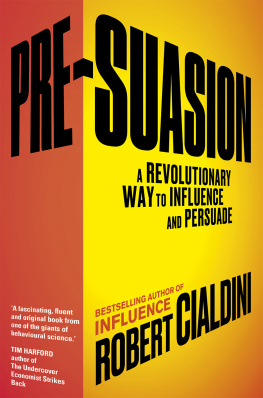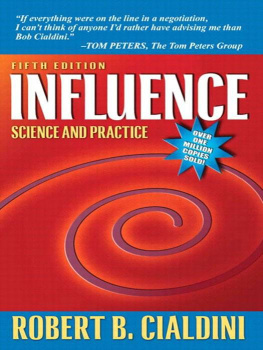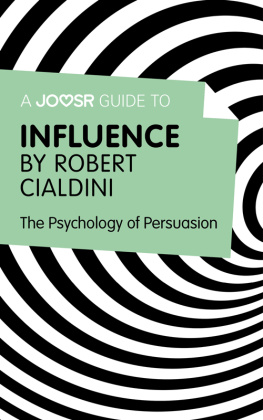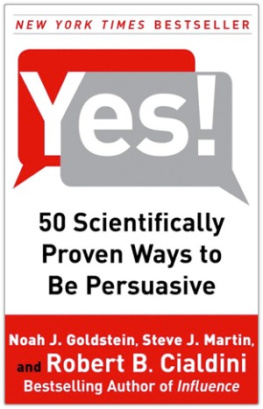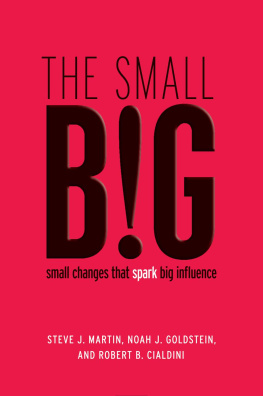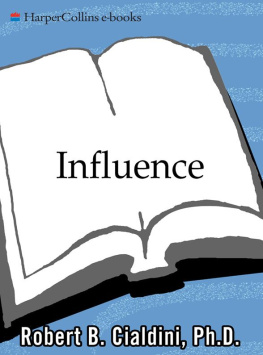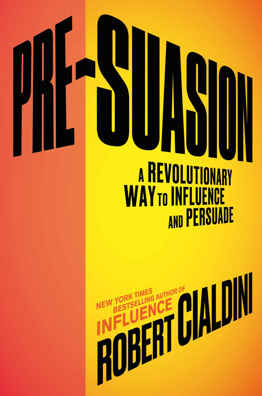Robert B. Cialdini - Influence: The Psychology of Persuasion
Here you can read online Robert B. Cialdini - Influence: The Psychology of Persuasion full text of the book (entire story) in english for free. Download pdf and epub, get meaning, cover and reviews about this ebook. year: 2009, publisher: HarperCollins, genre: Romance novel. Description of the work, (preface) as well as reviews are available. Best literature library LitArk.com created for fans of good reading and offers a wide selection of genres:
Romance novel
Science fiction
Adventure
Detective
Science
History
Home and family
Prose
Art
Politics
Computer
Non-fiction
Religion
Business
Children
Humor
Choose a favorite category and find really read worthwhile books. Enjoy immersion in the world of imagination, feel the emotions of the characters or learn something new for yourself, make an fascinating discovery.
- Book:Influence: The Psychology of Persuasion
- Author:
- Publisher:HarperCollins
- Genre:
- Year:2009
- Rating:3 / 5
- Favourites:Add to favourites
- Your mark:
- 60
- 1
- 2
- 3
- 4
- 5
Influence: The Psychology of Persuasion: summary, description and annotation
We offer to read an annotation, description, summary or preface (depends on what the author of the book "Influence: The Psychology of Persuasion" wrote himself). If you haven't found the necessary information about the book — write in the comments, we will try to find it.
Influence: The Psychology of Persuasion — read online for free the complete book (whole text) full work
Below is the text of the book, divided by pages. System saving the place of the last page read, allows you to conveniently read the book "Influence: The Psychology of Persuasion" online for free, without having to search again every time where you left off. Put a bookmark, and you can go to the page where you finished reading at any time.
Font size:
Interval:
Bookmark:
The Psychology of Persuasion

This book is dedicated to Chris,
who glows in his fathers eye
Weapons of Influence
Reciprocation: The Old Give and Takeand Take
Commitment and Consistency: Hobgoblins of the Mind
Social Proof: Truths Are Us
Liking: The Friendly Thief
Authority: Directed Deference
Scarcity: The Rule of the Few
Instant Influence: Primitive Consent for an Automatic Age
I can admit it freely now. All my life Ive been a patsy. For as long as I can recall, Ive been an easy mark for the pitches of peddlers, fund-raisers, and operators of one sort or another. True, only some of these people have had dishonorable motives. The othersrepresentatives of certain charitable agencies, for instancehave had the best of intentions. No matter. With personally disquieting frequency, I have always found myself in possession of unwanted magazine subscriptions or tickets to the sanitation workers ball. Probably this long-standing status as sucker accounts for my interest in the study of compliance: Just what are the factors that cause one person to say yes to another person? And which techniques most effectively use these factors to bring about such compliance? I wondered why it is that a request stated in a certain way will be rejected, while a request that asks for the same favor in a slightly different fashion will be successful.
So in my role as an experimental social psychologist, I began to do research into the psychology of compliance. At first the research took the form of experiments performed, for the most part, in my laboratory and on college students. I wanted to find out which psychological principles influence the tendency to comply with a request. Right now, psychologists know quite a bit about these principleswhat they are and how they work. I have characterized such principles as weapons of influence and will report on some of the most important in the upcoming chapters.
After a time, though, I began to realize that the experimental work, while necessary, wasnt enough. It didnt allow me to judge the importance of the principles in the world beyond the psychology building and the campus where I was examining them. It became clear that if I was to understand fully the psycholgy of compliance, I would need to broaden my scope of investigation. I would need to look to the compliance professionalsthe people who had been using the principles on me all my life. They know what works and what doesnt; the law of survival of the fittest assures it. Their business is to make us comply, and their livelihoods depend on it. Those who dont know how to get people to say yes soon fall away; those who do, stay and flourish.
Of course, the compliance professionals arent the only ones who know about and use these principles to help them get their way. We all employ them and fall victim to them, to some degree, in our daily interactions with neighbors, friends, lovers, and offspring. But the compliance practitioners have much more than the vague and amateurish understanding of what works than the rest of us have. As I thought about it, I knew that they represented the richest vein of information about compliance available to me. For nearly three years, then, I combined my experimental studies with a decidedly more entertaining program of systematic immersion into the world of compliance professionalssales operators, fund-raisers, recruiters, advertisers, and others.
The purpose was to observe, from the inside, the techniques and strategies most commonly and effectively used by a broad range of compliance practitioners. That program of observation sometimes took the form of interviews with the practitioners themselves and sometimes with the natural enemies (for example, police buncosquad officers, consumer agencies) of certain of the practitioners. At other times it involved an intensive examination of the written materials by which compliance techniques are passed down from one generation to anothersales manuals and the like.
Most frequently, though, it has taken the form of participant observation. Participant observation is a research approach in which the researcher becomes a spy of sorts. With disguised identity and intent, the investigator infiltrates the setting of interest and becomes a full-fledged participant in the group to be studied. So when I wanted to learn about the compliance tactics of encyclopedia (or vacuum-cleaner, or portrait-photography, or dance-lesson) sales organizations, I would answer a newspaper ad for sales trainees and have them teach me their methods. Using similar but not identical approaches, I was able to penetrate advertising, public-relations, and fund-raising agencies to examine their techniques. Much of the evidence presented in this book, then, comes from my experience posing as a compliance professional, or aspiring professional, in a large variety of organizations dedicated to getting us to say yes.
One aspect of what I learned in this three-year period of participant observation was most instructive. Although there are thousands of different tactics that compliance practitioners employ to produce yes, the majority fall within six basic categories. Each of these categories is governed by a fundamental psychological principle that directs human behavior and, in so doing, gives the tactics their power. The book is organized around these six principles, one to a chapter. The principlesconsistency, reciprocation, social proof, authority, liking, and scarcityare each discussed in terms of their function in the society and in terms of how their enormous force can be commissioned by a compliance professional who deftly incorporates them into requests for purchases, donations, concessions, votes, assent, etc. It is worthy of note that I have not included among the six principles the simple rule of material self-interestthat people want to get the most and pay the least for their choices. This omission does not stem from any perception on my part that the desire to maximize benefits and minimize costs is unimportant in driving our decisions. Nor does it come from any evidence I have that compliance professionals ignore the power of this rule. Quite the opposite: In my investigations, I frequently saw practitioners use (sometimes honestly, sometimes not) the compelling I can give you a good deal approach. I choose not to treat the material self-interest rule separately in this book because I see it as a motivational given, as a goes-without-saying factor that deserves acknowledgment but not extensive description.
Finally, each principle is examined as to its ability to produce a distinct kind of automatic, mindless compliance from people, that is, a willingness to say yes without thinking first. The evidence suggests that the ever-accelerating pace and informational crush of modern life will make this particular form of unthinking compliance more and more prevalent in the future. It will be increasingly important for the society, therefore, to understand the how and why of automatic influence.
It has been some time since the first edition of Influence was published. In the interim, some things have happened that I feel deserve a place in this new edition. First, we now know more about the influence process than before. The study of persuasion, compliance, and change has advanced, and the pages that follow have been adapted to reflect that progress. In addition to an overall update of the material, I have included a new feature that was stimulated by the responses of prior readers.
That new feature highlights the experiences of individuals who have read Influence , recognized how one of the principles worked on (or for) them in a particular instance, and wrote to me describing the event. Their descriptions, which appear in the Readers Reports at the end of each chapter, illustrate how easily and frequently we can fall victim to the pull of the influence process in our everyday lives.
Font size:
Interval:
Bookmark:
Similar books «Influence: The Psychology of Persuasion»
Look at similar books to Influence: The Psychology of Persuasion. We have selected literature similar in name and meaning in the hope of providing readers with more options to find new, interesting, not yet read works.
Discussion, reviews of the book Influence: The Psychology of Persuasion and just readers' own opinions. Leave your comments, write what you think about the work, its meaning or the main characters. Specify what exactly you liked and what you didn't like, and why you think so.



